
When plants moved ashore and changed the planet
Plants today are extremely diverse, abundant, and flamboyant. However, the first land plants, which initiated a great change in the flora and fauna on planet Earth, were very different.

Did you know that there are flowering plants that live in the sea? The unique characteristics of seagrasses are vital for the health of our planet.
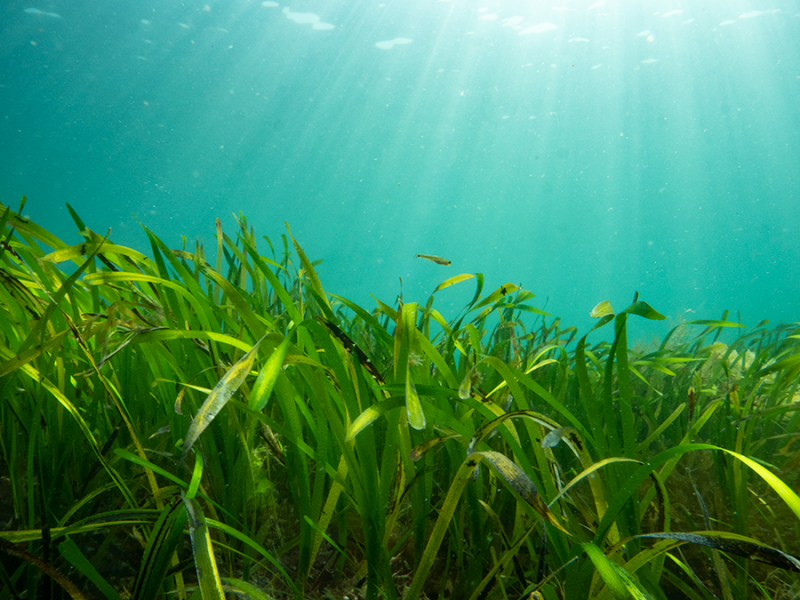
We live on a blue planet, over 70% of the planet’s surface is covered by water. The ocean provides humankind with oxygen, food, and medicines. It regulates the climate, is a key mode of transportation, is home to an incredible diversity of plant and animal species, and is a place where we can have fun above and below the waves. Unfortunately, our ocean and habitats are under threat. Coral reefs are often highlighted as a habitat that needs protection/restoration, but coral reefs are only found in tropical and subtropical waters around the equator. Seagrass meadows (figure 1) are found across the globe from the tropics to the arctic, around the coasts of 159 countries,[1] but until recently seagrass attracted little attention.
Seagrasses are not seaweeds, they are a plant; in fact they are the only flowering plant found in shallow marine environments, such as estuaries, sheltered bays, and lagoons. When you float over a thriving seagrass meadow, with the sun’s rays penetrating the water’s surface, it looks very much like a grassy meadow on land (figure 2). Sunlight is important because seagrasses, just like terrestrial plants, use sunlight to photosynthesize, by absorbing carbon dioxide to create oxygen and energy in the form of sugar. Unlike more diverse terrestrial grasslands, a seagrass meadow is made up of only one or two species of seagrass but is home to a myriad of species from small invertebrates, like snails and crabs, to larger animals, like turtles and dugongs.
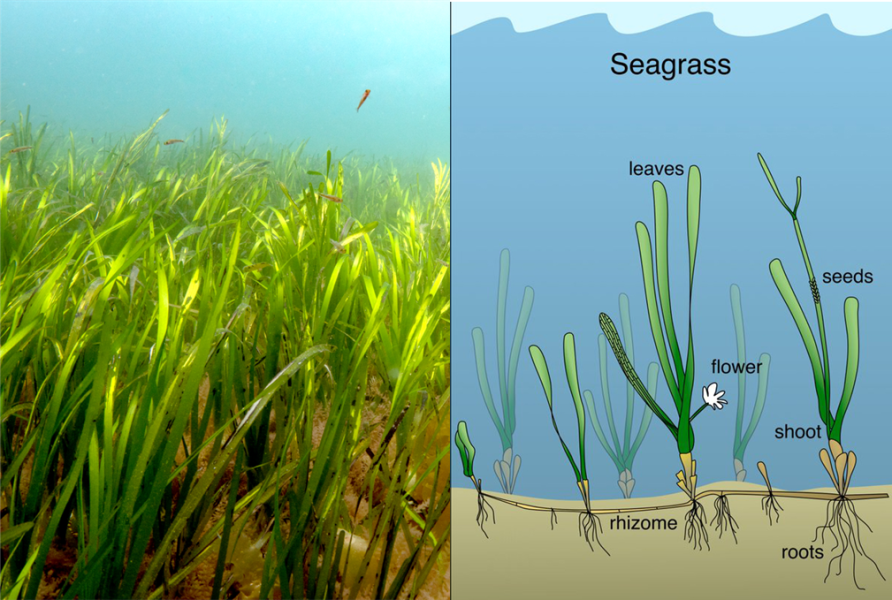
Seagrass has rhizomes that grow horizontally within the sediment, from which new plants can grow (asexual/vegetative reproduction; see figure 2), and they also produce flowers for sexual reproduction (figure 3).[2,3] Different seagrass species have different flower systems: some, like eelgrass (Zostera marina) have distinct male and female flowers,[4] and others, like Neptune grass (Posidonia oceanica), have hermaphrodite flowers with both male (stamen) and female (carpel) structures.[5] Just like land plants, the stamens produce pollen, which can be carried by the water currents or marine animals[2] to other flowers for fertilization, and the resulting seeds grow into new plants. However, seeds are vulnerable to predation and at the mercy of the ocean environment, so vegetative reproduction through rhizomes remains an important strategy.[6]
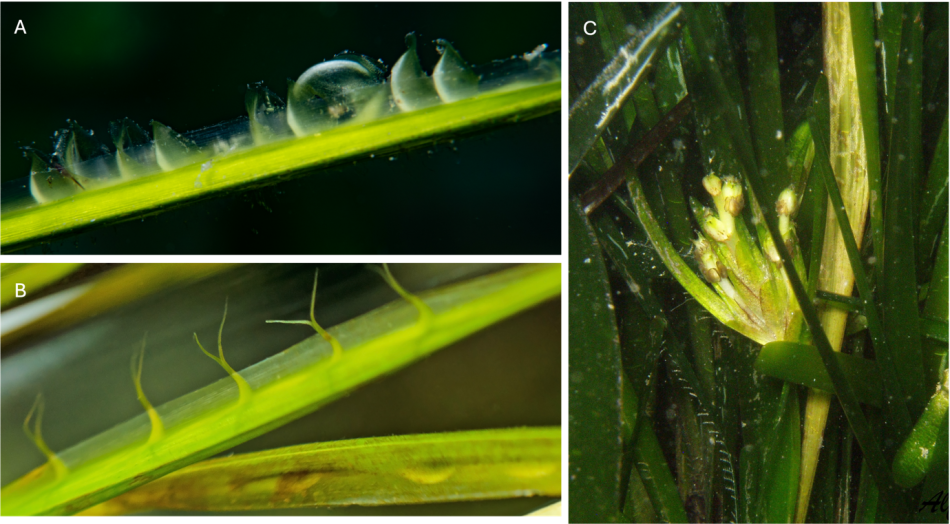
An established, healthy, dense seagrass meadow provides numerous benefits to marine ecosystems and humanity, but global seagrasses are under threat.
Seagrasses have been in decline since the 1930s, when a wasting disease decimated 90% of the meadows in the North Atlantic.[7] Furthermore, in recent years a variety of human-driven factors have reduced the extent of seagrass meadows across the globe. Coastal development, pollution, dredging, climate change, and overfishing have all either physically damaged or restricted the growth of seagrass (figure 4).[1,8]
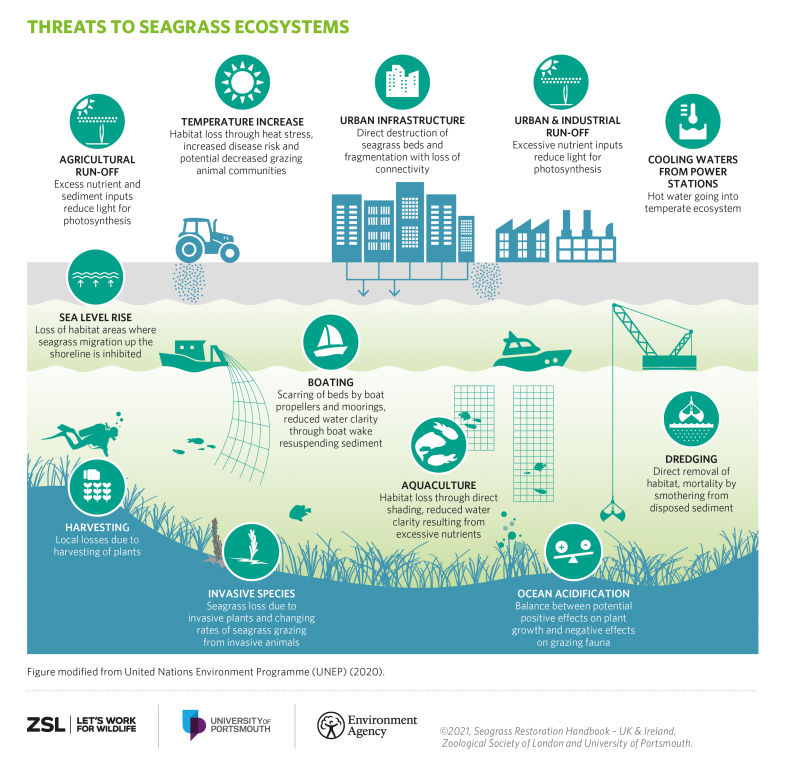
Seagrass offers huge benefits to humanity.[9] First and foremost, seagrass provides a vital habitat for a vast range of marine species. Some species that rely on the seagrass for food and/or shelter are threatened, endangered, or critically endangered according to the International Union for Conservation of Nature (IUCN). Seahorses, like the short-snouted seahorse (figure 5), cruise around a meadow and anchor to the grass by their tails. Seagrass comprises up to 90% of the diet of larger species, such as dugongs, which spend their days grazing the seagrass like a cow grazes on land, hence dugongs sometimes being referred to as ‘sea cows’.
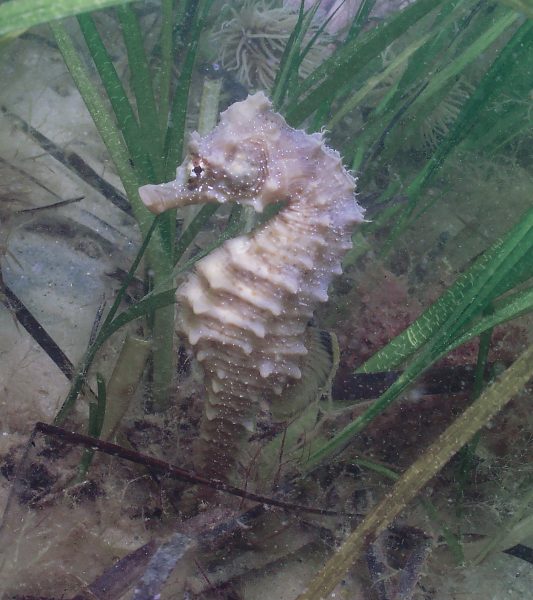
Seagrass meadows are also home to commercially important fish and shellfish, ironic given that fishing gear such as trawls and dredges destroy the seagrass.[1,10,11] However, the value of seagrass as a nursery ground for species like cod and pollock is now being recognized.[1,12] The meadows provide shelter for juvenile fish (figure 6) which helps to maintain healthy populations of commercially important species and a balanced ecosystem, which in turn provides a livelihood for coastal communities.
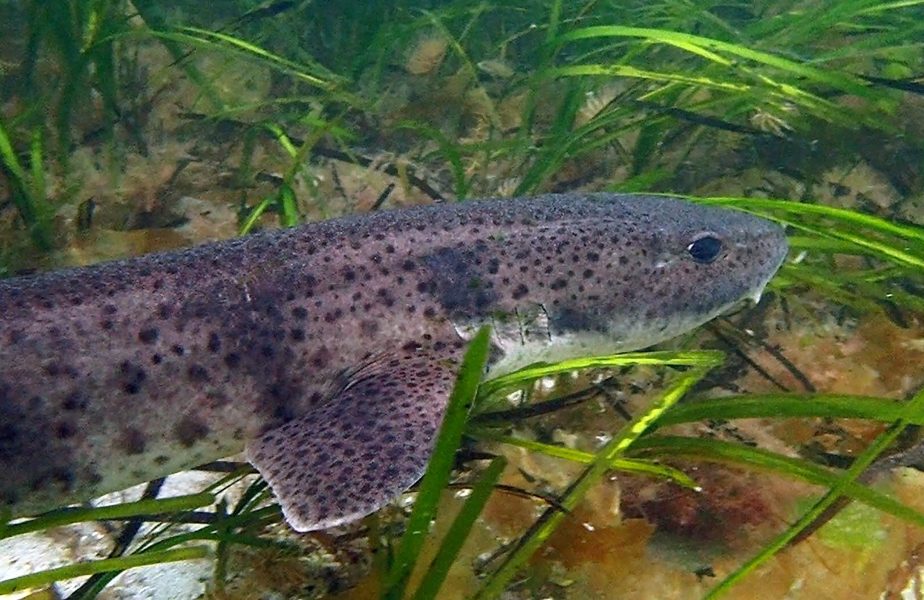
Other benefits of seagrass meadows are the important role they play in reducing coastal erosion. A healthy meadow can reduce the energy of waves and currents,[13] helping to protect shorelines from erosion. They also trap sediment and organic matter,[13] which can stabilize shorelines. Meadows also improve water quality by filtering nutrients and pollutants[13] from the water column, which in turn reduces the impact of harmful algal blooms.
As the impact of climate change becomes ever more evident, the value of seagrass to sequester and store carbonhas drawn much attention in recent years. Seagrasses, like saltmarsh, mangroves, and kelp forests, are a marine ecosystem that sequesters carbon, referred to as ‘Blue Carbon’, which makes them essential in the fight against climate change.[14,15] Seagrass meadows are highly efficient at capturing and storing carbon from the atmosphere. During photosynthesis, seagrasses take up carbon dioxide and incorporate it into organic compounds, which they store in their tissues. This removes carbon dioxide from the water, which means that seagrasses act as a buffer to ocean acidification. Additionally, when the plant dies and sheds its leaves, this organic matter sinks to the sediment below where it is buried and stored for long periods of time, removing the carbon from the atmosphere. Seagrasses can do this up to 35 times faster than a rainforest,[16,17] so we urgently need to take action to protect seagrass meadows.
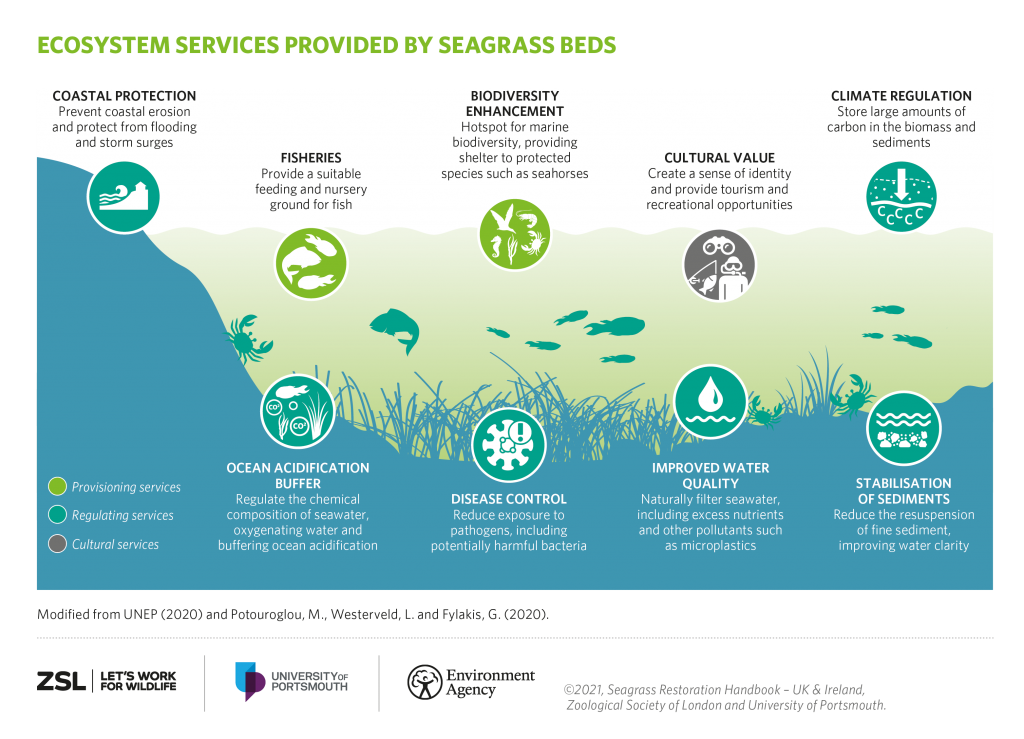
We now recognize the value of seagrasses to humanity, especially in the fight against climate change, which has led to international support and collaboration to conserve existing meadows by reducing pressures and restoring or planting new meadows.[1,18,19]
Reducing pressures requires innovation, cooperation, and policy. Better land management and wastewater treatments improve water quality. Implementation of sustainable fishing practices can reduce destruction, and education and engagement with coastal communities are helping to conserve meadows. Restoration can be more challenging, but pioneering work in Chesapeake Bay[6] on the east coast of the USA has demonstrated that it is possible to restore large areas of one species (Z. marina). In the Mediterranean, there are a number of projects to protect and restore P. Oceanica.[16]
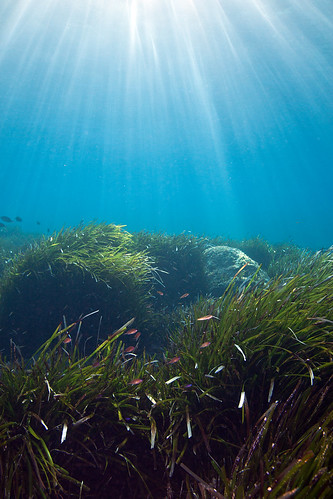
The Reducing and Mitigating Erosion and Disturbance Impacts affEcting the Seabed (ReMEDIES) program, funded by EU LIFE, is England’s largest seagrass restoration project and aims to restore 8 ha of seagrass by 2024. Several methods are being trialled at two sites that were selected using habitat suitability models with seed collected from nearby healthy meadows. It is hoped that, alongside work being conducted by other projects such as Project Seagrass, the UK and Europe will see seagrass meadows flourish and fulfil a role in mitigating climate change.
Seagrass meadows are an amazing habitat, seagrasses are a wonder plant!
[1] United Nations Environment Programme (2020) Out of the blue: The value of seagrasses to the environment and to people. UNEP, Nairobi. ISBN: 978-92-807-3780-6
[2] An informative document on seagrass: https://ocean.si.edu/ocean-life/plants-algae/seagrass-and-seagrass-beds
[3] The life cycle of Z. marina: https://depts.washington.edu/fhl/mb/Zostera_Jess/Life%20History.html
[4] Z. marina fact sheet: https://plants.usda.gov/DocumentLibrary/factsheet/pdf/fs_zoma.pdf
[5] Remizowa MV et al. (2012) Flowers and inflorescences of the seagrass Posidonia (Posidoniaceae, Alismatales) American journal of botany 99: 1592–608. doi: 10.3732/ajb.1200227
[6] Vercaemer BM et al. (2021) Reproductive ecology of Zostera marina L. (eelgrass) across varying environmental conditions. Aquatic botany 175. doi: 10.1016/j.aquabot.2021.103444
[7] de los Santos CB et al. (2019) Recent trend reversal for declining European seagrass meadows. Nature Communications 10: 3356. doi:10.1038/s41467-019-11340-4
[8] Waycott M et al. (2009) Accelerating loss of seagrasses across the globe threatens coastal ecosystems. Biological sciences 106: 12377–12381. doi: 10.1073/pnas.0905620106
[9] United Nations report on the importance of seagrasses: https://www.unep.org/resources/report/out-blue-value-seagrasses-environment-and-people
[10] Orth RJ et al. (2006) A Global Crisis for Seagrass Ecosystems. BioScience 56: 987–996. doi: 10.1641/0006-3568(2006)56[987:AGCFSE]2.0.CO;2
[11] An assessment of the impacts from current and potential fishing activities: https://www.gov.wales/sites/default/files/publications/2022-05/beam-trawl-on-seagrass-special-areas-conservation_0.pdf
[12] Unsworth RKF, Nordlund LM, Cullen-Unsworth LC (2018) Seagrass meadows support global fisheries production. Conservation Letters 12. doi: 10.1111/conl.12566
[13] Nordlund LM et al. (2018) Seagrass ecosystem services – What’s next? Marine Pollution Bulletin 134: 145–151. doi: 10.1016/j.marpolbul.2017.09.014
[14] Barnes DKA (2020) What Is Blue Carbon and Why Is It Important? Frontiers for Young Minds 8: 154. doi: 10.3389/frym.2019.00154
[15] Mcleod E et al. (2011) A blueprint for blue carbon: toward an improved understanding of the role of vegetated coastal habitats in sequestering CO2. Frontiers in Ecology and the Environment 9: 552–560. doi: 10.1890/110004
[16] Read about seagrasses on the WWF website: www.wwf.org.uk/what-we-do/planting-hope-how-seagrass-can-tackle-climate-change
[17] Aydin O et al. (2022) Conservation planning implications of modeling seagrass habitats with sparse absence data: a balanced random forest approach. Journal of Coastal Conservation 26. doi: 10.1007/s11852-022-00868-1
[18] Cullen-Unsworth LC, Unsworth RKF (2016) Strategies to enhance the resilience of the world’s seagrass meadows. Journal of Applied Ecology 53: 967–972. doi: 10.1111/1365-2664.12637
[19] Unsworth RKF et al. (2022) The planetary role of seagrass conservation. Science 377: 609–613. doi: 10.1126/science.abq6923

Plants today are extremely diverse, abundant, and flamboyant. However, the first land plants, which initiated a great change in the flora and fauna on planet Earth, were very different.
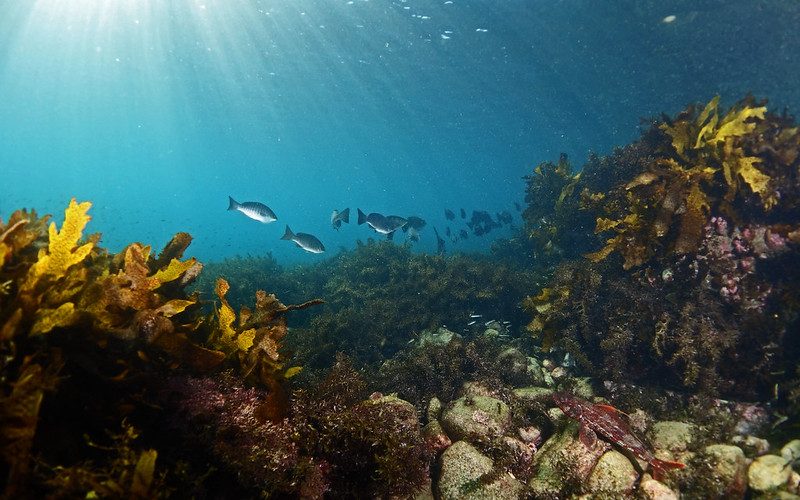
The oceans cover over 70% of the surface of our planet. Try these activities to learn more about Earth’s largest habitat and how it affects our lives.
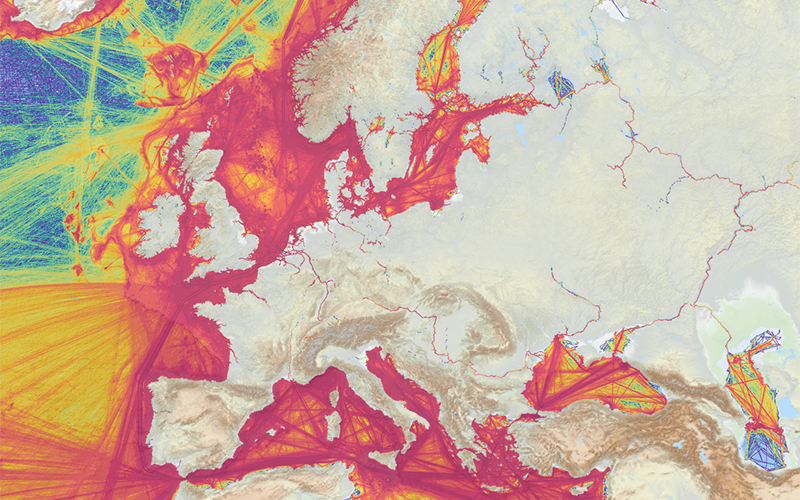
Looking for a user-friendly interactive map-based educational tool on the ocean? Dive into the European Atlas of the…